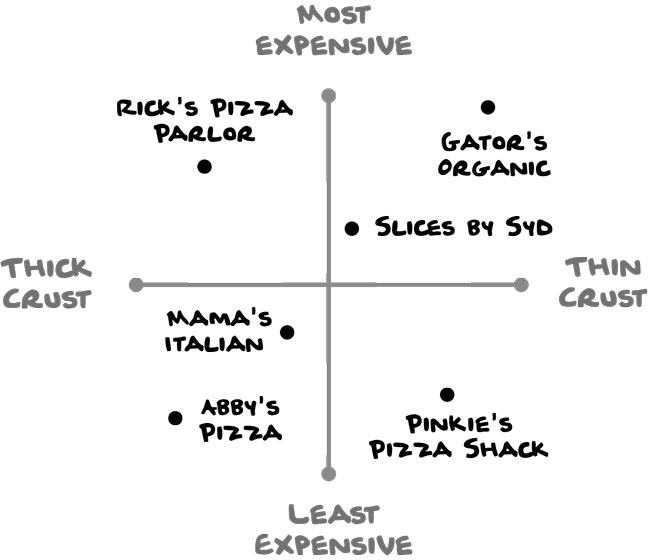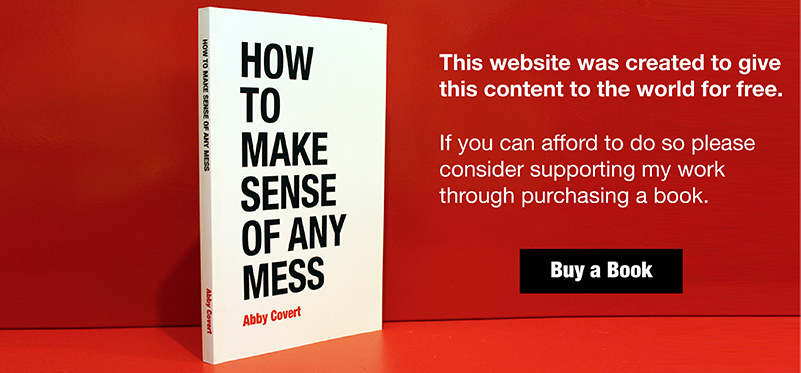Exact (adjective.)
Definition: A precise way of classifying things.
Also referenced as: Exactly (adverb) Exactness (noun) Exactitude (noun)
Related to: Ambiguous, Classification
Chapter 1: Identify the Mess | Page 24
Users are complex.
User is another word for a person. But when we use that word to describe someone else, we’re likely implying that they’re using the thing we’re making. It could be a website, a product or service, a grocery store, a museum exhibit, or anything else people interact with.
When it comes to our use and interpretation of things, people are complex creatures.
We’re full of contradictions. We’re known to exhibit strange behaviors. From how we use mobile phones to how we traverse grocery stores, none of us are exactly the same. We don’t know why we do what we do. We don’t really know why we like what we like, but we do know it when we see it. We’re fickle.
We expect things to be digital, but also, in many cases, physical. We want things to feel auto-magic while retaining a human touch. We want to be safe, but not spied on. We use words at our whim.
Most importantly perhaps, we realize that for the first time ever, we have easy access to other people’s experiences to help us decide if something is worth experiencing at all.
Chapter 3: Face Reality | Page 69
4. Quadrant Diagram
A quadrant diagram illustrates how things compare to one another. You can create one based on exact data (e.g., price of a slice, thickness of pizza-crust) or ambiguous data (e.g., fancy or casual, quality of service, or tastiness).
This diagram would be more exact with prices and crust measurements. (But how do you properly measure the thickness of pizza crust anyways?)

Chapter 4: Choose a Direction | Page 99
Think about relationships between nouns and verbs.
When you combine nouns with appropriate verbs, the resulting sentences can be referred to as requirements for what you’re making.
From the previous example:
- An author can write a post.
- An author can delete a post.
- Any user can share a post.
- Any user can read a post.
This list of requirements defines the ideal solution. Each requirement tells us who should be able to do what in the eventual state.
When you take the time to make requirements concrete and prioritize them, you can better understand what you’re actually making.
If you’re designing an interface that prioritizes reading, it will be fundamentally different than an interface that prioritizes writing, even with the exact same list of requirements.
Chapter 6: Play with Structure | Page 129
Classification can be exact or ambiguous.
Postal codes are what we call an exact classification. We can generally rely on the codes to hold steady. If the postal code is 10012, the building is in Manhattan. There’s nothing to argue about. It just is.
Ambiguous classifications require more thought to decide where something goes. The more ambiguous something is, the more it can be argued about.
Movie genres like Comedy and Drama may seem exact. But if you put three movie reviewers in a room and ask them to classify a dark comedy into one of those two genres, they may challenge each other.
Ambiguity and exactness relate to context as well.
For example, in editing this book, Nicole suggested I use the term “Postal code” instead of “Zip code” in the example above. Both would have expressed the point, but one is more exact for our context, which includes readers outside of the United States.
Chapter 6: Play with Structure | Page 130
Ambiguity costs clarity; exactitude costs flexibility.
The more ambiguous you are, the more likely it is that people will have trouble using your taxonomy to find and classify things.
For every ambiguous rule of classification you use or label you hide behind, you’ll have to communicate your intent that much more clearly.
For example, what if I had organized the lexicon in the back of this book by chapter, instead of alphabetically? This might be an interesting way of arranging things, but it would need to be explained, so you could find a term.
The more exact your taxonomy becomes, the less flexible it is. This isn’t always bad, but it can be. If you introduce something that doesn’t fit into a category things can get confusing.
Because there are many words for the same thing, exact classifications can slow us down. For example, I recently tried to buy some zucchini at a grocery store. But it wasn’t until the clerk in training found the code for “Squash, Green” that she could ring me up.
Chapter 6: Play with Structure | Page 133
Identify facets.
What are five other facets of a vinyl record?
- _______________________
- _______________________
- _______________________
- _______________________
- _______________________
Consider:
- Which of these facets are most ambiguous?
- Which of these facets are most exact?
- Which of these facets would make sense for organizing a record store?
- Which of these facets would make sense for organizing a personal collection of records?
Now search Google for “John Cusack organizes records autobiographically” and think about the facets that Cusack’s character would need to sort his collection that way.
Chapter 6: Play with Structure | Page 134
Humans are complex.
Tomatoes are scientifically classified as a fruit. Some people know this and some don’t. The tomato is a great example of the vast disagreements humans have with established exact classifications.
Our mental models shape our behavior and how we relate to information.
In the case of the tomato, there are clearly differences between what science classifies as a fruit and what humans consider appropriate for fruit salad.
If you owned an online grocery service, would you dare to only list tomatoes as fruit?
Sure, you could avoid the fruit or vegetable debate entirely by classifying everything as “produce,” or you could list tomatoes in “fruit” and “vegetables.”
But what if I told you that squash, olives, cucumbers, avocados, eggplant, peppers, and okra are also fruits that are commonly mistaken as vegetables?
What do we even mean when we say “fruit” or “vegetable” in casual conversations? Classification systems can be unhelpful and indistinguishable when you’re sorting things for a particular context.
Chapter 6: Play with Structure | Page 144
Play with Structure
Because your structure may change a hundred times before you finish making it, you can save time and frustration by thinking with boxes and arrows before making real changes. Boxes and arrows are easier to move around than the other materials we work with, so start there.
Try structuring the mess with common patterns of boxes and arrows as shown on the next page. Remember that you’ll probably need to combine more than one pattern to find a structure that works.
- Assess the content and facets that are useful for what you’re trying to convey.
- Play with broad and shallow versus narrow and deep hierarchies. Consider the right place to use heterarchies, sequences, and hypertext arrangements.
- Arrange things one way and then come up with another way. Compare and contrast them. Ask other people for input.
- Think about the appropriate level of ambiguity or exactitude for classifying and labeling things within the structure you’re pursuing.
